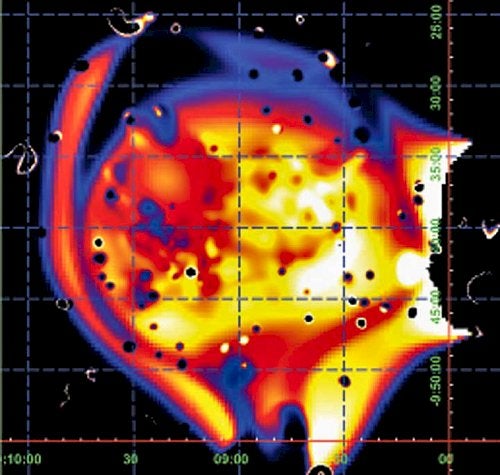
“A lot of fireworks happen when the most massive things in the universe slam together,” notes Henry. “Galaxies whiz by each other and the cluster gas is heated to hundreds of millions of degrees.”
Collisions and mergers are essential parts of how the universe progressed from a smooth, structureless state right after the Big Bang into what we see today, where galaxies group into clusters, and clusters of galaxies form still-larger structures. Says Richard Mushotzky of NASA’s Goddard Space Flight Center, “Detailed theory says that all objects in the universe form from mergers: small things coming together to form big things.”
The new observations from XMM-Newton reveal the merger with unprecedented clarity. Notes team leader Henry, “We are able to see things in nature seen previously only in computer simulations. The agreement of the data with the simulations shows that our understanding of even the details of these mergers is correct.”
“This is our best view yet of one of the most powerful events in the universe: the merging of two large galaxy clusters,” says Michael Salamon of NASA Headquarters, who is not part of the team reporting the results. “These images give us a snapshot of the biggest collision we know of.”
September 24, 2004
A gigantic collision between two clusters of galaxies has been observed by astronomers at X-ray wavelengths using the European Space Agency’s XMM-Newton satellite observatory. The collision, the astronomers say, is the largest ever studied in detail. It involves more than a thousand galaxies containing trillions of stars, large quantities of very hot gas, and a still-larger amount of unseen dark matter. The team of astronomers reporting the observation likens the collision to a “perfect storm.”
“Today’s cosmic weather report shows a violent storm a million light-years across, as two high-pressure regions collide in a nearby galaxy cluster,” says team leader J. Patrick Henry of the University of Hawaii. The other team members are Alexis Finoguenov and Ulrich G. Briel of the Max Planck Institute for Extraterrestrial Physics in Germany. Their results will be published in a future issue of The Astrophysical Journal.
The head-on collision spans several million light-years, and if we could see the hot, stormy region by eye it would cover about half the Full Moon’s size. The collision involves two clusters of galaxies that are part of a larger galaxy cluster called Abell 754. The two colliding clusters contain about 1,000 and 300 galaxies, respectively. The smaller galaxy cluster has about the mass of the Virgo cluster (which lies 60 million light-years from Earth), while the larger one is about the mass of the Coma cluster (300 million light-years away). Abell 754 lies in Hydra, about 800 million light-years from Earth, making it relatively easy to observe.
Astronomers are catching the merger partway through the process. According to team member Finoguenov, one cluster apparently has smashed into the other and has since made one pass through it. “Now,” he says, “gravity will pull the remnants of this first cluster back toward the core of the second.” The two probably will merge into one larger cluster in about 7 billion years.









